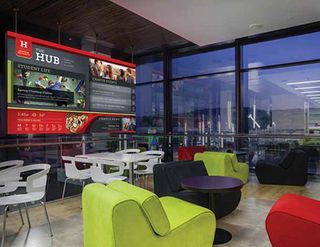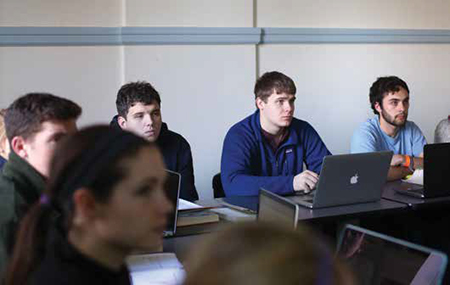The Bring Your Own Device (BYOD) phenomenon is almost single-handedly responsible for the moniker, “disruptive technologies.” The first iPad was released in 2010 and soon made its way into the classroom. Understanding, integrating, and standardizing on the iOS platform was disruptive, but somewhat defined. Those were the good old days of disruptive technologies.
Exacerbated by Bring Your Own Everything (BYOE) “disruptive” has become the norm. Jesse Anderson, CTS-D, audio-visual services director for Information Technology Services at College of the Holy Cross, and chair of the InfoComm Technology Managers Council said, “At Technology Managers’ Council meeting during InfoComm 2015 we spent most of our time discussing Bring Your Own Device (BYOD) and its implications—not only for us as AV managers, but for network administrators as well. Their use in the classroom is both exciting and terrifying; with the right apps they can take the place of a huge pile of source hardware, but since they started out as consumer devices they often don’t always ‘play well’ in a pro AV environment.”
Most managers reported that their users wanted to use whatever manufacturer-supported wireless video solution was available on their particular device. “This in and of itself is a challenge, as we knew of three different, incompatible, means of doing the video,” said Anderson.
AN IMMEDIATE NEED
The Sextant Group's system designer, David Glenn, RCDD, CTS-D, LEED AP BD+C, advises businesses and higher education institutions on BYOD strategies. He stressed this point: “Modern end-users demand interoperability, instant access to information, and mobility.” With Millennials surpassing Gen X workers to become the largest labor force, AV/IT managers must quickly adapt to BYOD. “Today’s youth, our next set of business executives, require 24/7 access to immediate information and have been ‘plugged in’ to technology since birth,” Glenn said. “The consumerization of AV/IT technology has created a society of knowledgeable, demanding users and technology managers must keep up with the end users’ expectations.”

Many colleges and universities are moving from trying to limit the number of personal devices used in the classroom. Jahn Westbrook, technical manager for Classroom Media Services for New York University said, “We encourage and anticipate BYOD is the majority of use in our classrooms. We are now exploring Wi-Fi connectivity, either on the IT network or as a sub-net focused in each classroom for presentation support.”
Until the close of the 2014/15 school year Gordon College located in Wenham, MA, has taken a measured and limited approach to BYOD support in classrooms. Chris Imming, CTS-I, CTS-D, director of media services, Classroom Design at Gordon College said, “This year we’re going to be deploying wireless collaboration devices such as the Mersive Solstice Pod, or the Kramer Via Series in select classrooms.” Noting that screen size is still a limiting factor for viewing at typical classroom distances, Imming is looking toward a screen sharing solution to be robust and provide some new opportunities in the classroom. “Our plan also includes deploying some of the new Sharp Aquos Board models and explore how screen sharing via Touch Display Link with bring your own devices will work in larger classroom spaces,” explained Imming.
TRYING TO CALM DISRUPTION
Nearly every software solutions and electronics manufacturing company is offering products to connect and share any number of devices and platforms. The Sextant Group's principal consultant, Craig Park, FSMPS, ASSOC. AIA, concurs. “We see a continuing growth in ‘screen sharing’ solutions like Mersive’s Solstice Pod joining the already crowded market (AMX Enzo, Barco ClickShare, Crestron AirMedia, Christie Brio, etc.) for device-agnostic BYOD connectivity solutions," Park said. "However, there is still growing demand for more true collaboration platforms (e.g., TideBreak TeamSpot/ClassSpot, Kramer Via Collage) and I expect we’ll see that market grow, as well.”
Imming sees that wireless collaboration devices are finally starting to mature and offer mirroring support for Android, iOS, Windows, and OSX machines. But suggested, “There still seems to be need for strengthening the feature set and performance of this class of hardware but it is exciting to see it finally entering the classroom.”
For some, built-in solutions also may offer challenges on an enterprise wireless network,” College of the Holy Cross’ Anderson said. “Miracast, for example, tries to set up a peer-to-peer connection between the device and display, and Bonjour tries to advertise itself across the network. BOYD manufacturers are starting to respond to this,” he added. “Apple’s new pairing scheme (using Bluetooth rather than TCP/IP) is a good example, but in the mean time.”

The Planar DirectLight LED Video Wall System in Hampson University’s student union. POLICIES AND PROTOCOLS
A BYOD strategy should include a mobile device management (MDM) policy. “There are both on premises and cloud-based MDM solutions available to IT managers,” The Sextant Group’ Glenn said. “Without a thoughtfully implemented MDM plan, enterprise and corporate security will be left vulnerable to security risks. A necessary part of BYOD strategy, MDM policy must find the perfect balance between system security and meeting users’ expectations on the level of restrictions that will be applied to mobile devices.”
New York University’s Westbrook added, “We keep our EDID and DCHP protocols current, offer an auxiliary panel for connection into our equipment and have a cache of adaptors supporting virtually any personal source to connect either by VGA or HDMI.”
It is important to understand the type of content that will be presented and its level of sensitivity, Glenn stressed. “There are varied levels of encryption available across presentation solutions.”
BYOD and wireless are a natural evolution, but expectations need to be managed and implementation carefully planned. Anderson see the biggest challenge in the next few years is wireless AV. “Our users want the same experience in the classroom that they can have in their living room, and we’ve found that many consumer devices weren’t designed for enterprise networks” he said. But with multiple IT groups working together, each bringing expertise in their particular area, Anderson has usually found creative solutions to please users. “At Holy Cross, we are using a management package on our wireless network to geofence Bonjour traffic, Anderson said. This lets iOS users see the devices that are available from their current wireless AP without seeing the rest across campus.”
The inherent challenge with wireless is that many users share the bandwidth of the connection. Even newer wireless standards, such as 802.11 AC, can only help the bottleneck, because as the number of users and devices goes up, the slices of bandwidth get smaller. “To help with this, make sure that your media player is attached to a wired network port,” Anderson suggested. “Wireless bandwidth is shared, and if the player is wireless you take a double-hit on the traffic—device to access point, and access point to player.”
Certainly bandwidth needs have increased as BYOD and Internet of Things (IoT) devices have increased on campuses, but Imming is seeing this as an opportunity. This has required Gordon College to invest more into additional higher speed wireless access points across the campus and ISP resources. Imming said, “At the same time the demand for number of physical wired network connections has appeared to decline, so we may be able to shift resources that used to be allocated to switches be redistributed to ISP bandwidth and supporting robust wireless offerings.”
Info
barco.com
gordon.edu
holycross.edu
planar.com
thesextantgroup.com
sharp-sbs.com
Accelerate Active Learning with Key AV Tools
We all learn differently. We act differently, we respond differently and we communicate differently. Variety is very much the spice of life. But it can also cause roadblocks for the ways in which we absorb information. Some people can see something once and remember it, while others study it for days on end only to vaguely recall a small fraction of the information. While some of that is based on IQ levels, optimal memory retention is achieved by also maximizing one of three possible learning styles: Visual, Auditory, or Kinesthetic.
In the educational market, engaging students through all three learning styles is the key to scholastic success. As such, it’s important to integrate classroom educational tools that can maximize the benefits for each learning style, leaving no student left out.
• Visual learners tend to learn best through graphs, charts, pictures, and body language, as well as watching lectures. In order to maximize visual learning capabilities, educators must captivate using visual tools, as with Power Point presentations using freestanding or whiteboard-mounted displays. Tools like these are mutually beneficial for students and teachers, as they present students with the material in their most optimized cognitive learning style, while teachers are able to pre-arrange presentations to use for multiple classes and/ or lesson plans.
• Auditory learners retain information based on verbal delivery. These are students who benefit from listening to lectures while recording them, and playing them back later as a study method. Repeating the information aloud as they learn it will also benefit these types of learners. AV equipment with recording devices can be a great learning tool, which teachers can either leave up to the students as a BYOD (Bring Your Own Device), or record their lectures and make them available online. Many projector mounts come with audio equipment to allow teachers to be heard clearly throughout large classrooms, thus allowing auditory learners to hear and record lesson plans without worrying about volume complications.
• Kinesthetic learners are the hands-on learners group. They prefer demonstrations, both from their teachers as well as self-delivered demonstrations as a means to recap a lesson. Hands-on learners, such as these, benefit from demonstrative learning with the help of interactive displays, which can be mounted to existing whiteboards with the right mount. Demonstrating material they’re working through is not only a benefit for them, but also as a means to reiterate lessons to the Visual and Auditory learners in the classroom.
As with any integration project, being aware of the goals of a classroom upgrade or design is the key to creating the best solution possible. Having high quality designs that are safe is especially important in any learning environment where students are at risk for injury due to faulty products.
Check all project hardware and mounting materials for compliance with UL testing standards, which provide optimal safety assurance. Plan ahead, get the facts, and optimize your options. After all, this is the education market. Think smart.
—Content courtesy of Premier Mounts (mounts.com)












